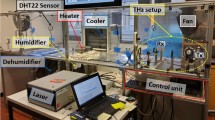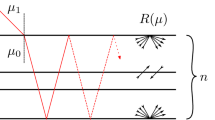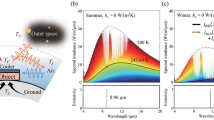Abstract
MARTYN1 proved theoretically that, provided the effect of the Earth's magnetic field was neglected, the absorption of a radiowave of frequency f incident obliquely on the ionosphere at an angle of incidence i was equal to the absorption of a vertically incident wave of frequency f cos i multiplied by the factor cos i (Martyn's absorption theorem). Experimental investigations of the theorem were undertaken by Beynon2 and Allcock3, both of whom concluded that its accuracy was considerably improved if the cos i multiplying factor was omitted. Later theoretical work4 supported the omission of the cos i term. The simple ray-theory on which Martyn's theorem is based breaks down at low frequencies because conditions in the ionosphere change appreciably within the distance of one wavelength. Allcock3 demonstrated experimentally, however, that to a first approximation the theorem was valid even at low (LF 30–300 kHz) and very low (VLF 10–30 kHz) frequencies. It has since become customary to express the reflexion coefficients of LF and VLF radiowaves propagated at oblique incidence in terms of vertical incidence propagation at an equivalent vertical frequency of f cos i and to assume that the reflexion coefficient will be the same for all paths having identical values of f cos i. Furthermore, effects resulting from changes of path direction relative to the Earth's magnetic field have also been neglected and no distinction drawn between the reflexion coefficient (∥R∥) and the conversion coefficient (∥R⊥) for angles of incidence less than 50°.
This is a preview of subscription content, access via your institution
Access options
Subscribe to this journal
Receive 51 print issues and online access
$199.00 per year
only $3.90 per issue
Buy this article
- Purchase on Springer Link
- Instant access to full article PDF
Prices may be subject to local taxes which are calculated during checkout
Similar content being viewed by others
References
Martyn, D. F., Proc. Phys. Soc., 47, 323 (1935).
Beynon, W. J. G., Proc. Inst. Elec. Eng., Part 3, 101, 15 (1954).
Allcock, G. McK., The Physics of the Ionosphere, 14 (The Physical Society, London, 1955).
Appleton, E. V., and Beynon, W. J. G., J. Atmos. Terr. Phys., 6, 141 (1955).
Pitteway, M. L. V., Phil. Trans. Roy. Soc., A, 257, 219 (1965).
Deeks, D. G., Proc. Roy. Soc., A, 291, 413 (1966).
Author information
Authors and Affiliations
Rights and permissions
About this article
Cite this article
JONES, T., WAND, I. Validity of the f cos i Theorem for the Absorption of Very Low Frequency Radiowaves in the Ionosphere. Nature 222, 462–463 (1969). https://doi.org/10.1038/222462a0
Received:
Issue Date:
DOI: https://doi.org/10.1038/222462a0
Comments
By submitting a comment you agree to abide by our Terms and Community Guidelines. If you find something abusive or that does not comply with our terms or guidelines please flag it as inappropriate.



